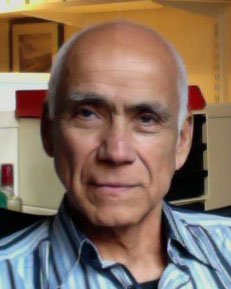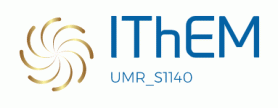
Angles-Cano Eduardo
M.D., Sc.D. Emeritus Director of Research at Inserm
Phone: 01 53 73 95 07
Biography
Eduardo ANGLES-CANO is M.D., Sc.D. Emeritus Director of Research at Inserm.
With my graduate students and co-workers we are pioneer in the study of fibrinolytic microvesicles (MVs) as functional messengers of plasmin generation. Since plasminogen activation is a property not only of vascular cells but also of other cell types including epithelial and inflammatory cells, our working hypothesis is that MVs derived from cells that express plasminogen activators may generate, disseminate and transfer plasmin proteolytic activity (Blood, 2007). For instance, besides endothelial cells and leucocytes, neurons are able to release microvesicles bearing plasmin and tPA activity (Biochem J 2010). We have found that endothelial cell- and leucocyte- derived microvesicles bear the machinery necessary for plasmin formation including plasminogen activators and its receptors: tPA for endothelial MVs and the uPA/uPAR system for leukocyte MVs (Haematologica 2013).
Furthermore, we have discovered a new mechanism for plasmin formation that bypass the requirement for co-assembly of plasminogen and uPA on the same surface (Blood 2010). These heterotypic cell-to-cell (platelets/ monocytes; platelets/MPs), cell-to-matrix (leukocytes/fibrin), or MPs-to-matrix (MPs/fibrin) proteolytic cross-talk represents an alternative pathway for localized plasmin formation that may be relevant to processes implicating cell migration and MP dissemination, i. e. inflammation or angiogenesis. Finally, our data provide additional evidence for a novel role of MPs and platelets, as vectors that generate and propagate plasmin fibrinolytic and/or proteolytic activity, and could thereby constitute a pharmacologic tool.
We are also studying the role of microvesicles in fibrinolysis and NET transformation of PMN in ischaemic diseases.
Current fields of interest:
- Microvesicles as messengers and actors of fibrinolytic and proteolytic activity
- Fibrinolysis and proteolysis in inflammatory diseases
- Microvesicles, fibrinolysis and NET transformation of PMN in ischaemic disease
- Plasminogen activation-dependent extracellular proteolytic activity in atherothrombosis
Major publications 2020 / 2010
Porphyromonas gingivalis triggers the shedding of inflammatory endothelial microvesicles that act as autocrine effectors of endothelial dysfunction. Isaac Maximiliano Bugueno, Fatiha Zobairi El-Ghazouani, Fareeha Batool, Hanine El Itawi, Eduardo Anglès-Cano, Nadia Benkirane-Jessel, Florence Toti, Olivier Huck – 2020 Feb 4 – PMID: 32019950 PMCID: PMC7000667 DOI: 10.1038/s41598-020-58374-z
DNA-bound elastase of neutrophil extracellular traps degrades plasminogen, reduces plasmin formation, and decreases fibrinolysis: proof of concept in septic shock plasma. Dayana Barbosa da Cruz, Julie Helms, Lluvia Ramírez Aquino, Laure Stiel, Lucas Cougourdan, Cedric Broussard, Philippe Chafey, Madeleine Riès-Kautt, Ferhat Meziani, Florence Toti, Pascale Gaussem, Eduardo Anglés-Cano. 2019 Dec -PMID: 31682515 DOI: 10.1096/fj.201901363RRR
Fibrin γ/γ’ influences the secretion of fibrinolytic components and clot structure. Miriam Cantero, Héctor Rojas, Eduardo Anglés-Cano, Rita Marchi – 2019 Nov 1 – PMID: 31675913 PMCID: PMC6824120 DOI: 10.1186/s12860-019-0233-0
Neutrophil Extracellular Traps Associate with Clinical Stages in Breast Cancer. Monica M Rivera-Franco, Eucario Leon-Rodriguez, José J Torres-Ruiz, Diana Gómez-Martín, Eduardo Angles-Cano , María de la Luz Sevilla-González – 2019 Oct 27 – PMID: 31656990 DOI: 10.1007/s12253-019-00763-5
Small size apolipoprotein(a) isoforms enhance inflammatory and proteolytic potential of collagen-primed monocytes. Nadia Sabbah, Stéphane Jaisson, Roselyne Garnotel, Eduardo Anglés-Cano, Philippe Gillery – 2019 Aug 31 – PMID: 31470857 PMCID: PMC6717332 DOI: 10.1186/s12944-019-1106-4
New Copper Compounds with Antiplatelet Aggregation Activity. Flores-Garcia M, Fernández-G JM, Busqueta-Griera C, Gomez E, Hernandez-Ortega S, Lamothe-Flores JCD, Gomez-Vidales V, Mejia-Dominguez AM, Angles-Cano E, de la Pena-Diaz A. Med Chem. 2019 Feb 22. doi: 10.2174/1573406415666190222123207.
Endothelial Microparticles are Associated to Pathogenesis of Idiopathic Pulmonary Fibrosis. Bacha NC, Blandinieres A, Rossi E, Gendron N, Nevo N, Lecourt S, Promising pharmacological profile of a Kunitz-type inhibitor in murine renal cell carcinoma model. de Souza JG, Morais KL, Anglés-Cano E, Boufleur P, de Mello ES, Maria DA, Origassa CS, de Campos Zampolli H, Câmara NO, Berra CM, Bosch RV, Chudzinski-Tavassi AM. Oncotarget. 2016 Sep 20;7(38):62255-62266. doi: 10.18632/oncotarget.11555.
Guerin CL, Renard JM, Gaussem P, Angles-Cano E, Boulanger CM, Israel-Biet D, Smadja DM. Stem Cell Rev. 2018 Apr;14(2):223-235.
Evidence of Netosis in Septic Shock-Induced Disseminated Intravascular Coagulation. Delabranche X, Stiel L, Severac F, Galoisy AC, Mauvieux L, Zobairi F, Lavigne T, Toti F, Anglès-Cano E, Meziani F, Boisramé-Helms J. Shock. 2017 Mar;47(3):313-317. doi: 10.1097/SHK.0000000000000719.
Endothelial fibrinolytic response onto an evolving matrix of fibrin. Castillo O, Rojas H, Domínguez Z, Anglés-Cano E, Marchi R. BMC Hematol. 2016 Apr 14;16:9. doi: 10.1186/s12878-016-0048-6.
Exome Sequencing and Clot Lysis Experiments Demonstrate the R458C Mutation of the Alpha Chain of Fibrinogen to be Associated with Impaired Fibrinolysis in a Family with Thrombophilia. Fernández-Cadenas I, Penalba A, Boada C, Carrerra C, Bueno SR, Quiroga A, Monasterio J, Delgado P, Anglés-Cano E, Montaner J. J Atheroscler Thromb. 2016;23(4):431-40. doi: 10.5551/jat.30676.
Evidence for several independent genetic variants affecting lipoprotein (a) cholesterol levels. Lu W, Cheng YC, Chen K, Wang H, Gerhard GS, Still CD, Chu X, Yang R, Parihar A, O’Connell JR, Pollin TI, Angles-Cano E, Quon MJ, Mitchell BD, Shuldiner AR, Fu M. Hum Mol Genet. 2015 Apr 15;24(8):2390-400. doi: 10.1093/hmg/ddu731.
Plasminogen in cerebrospinal fluid originates from circulating blood. Mezzapesa A, Orset C, Plawinski L, Doeuvre L, Martinez de Lizarrondo S, Chimienti G, Vivien D, Mansour A, Matà S, Pepe G, Anglés-Cano E. J Neuroinflammation. 2014 Sep 16;11:154. doi: 10.1186/s12974-014-0154-y.
Membrane microvesicles: a circulating source for fibrinolysis, new antithrombotic messengers. Plawinski L, Anglés-Cano E. Haematologica. 2013 Jul;98(7):e75-6. doi: 10.3324/haematol.2013.088948.
Molecular requirements for safer generation of thrombolytics by bioengineering the tissue-type plasminogen activator A chain. Parcq J, Bertrand T, Baron AF, Hommet Y, Anglès-Cano E, Vivien D. J Thromb Haemost. 2013 Mar;11(3):539-46. doi: 10.1111/jth.12128.
Unveiling an exceptional zymogen: the single-chain form of tPA is a selective activator of NMDA receptor-dependent signaling and neurotoxicity. Parcq J, Bertrand T, Montagne A, Baron AF, Macrez R, Billard JM, Briens A, Hommet Y, Wu J, Yepes M, Lijnen HR, Dutar P, Anglés-Cano E, Vivien D. Cell Death Differ. 2012 Dec;19(12):1983-91. doi: 10.1038/cdd.2012.86.
Leukocyte- and endothelial-derived microparticles: a circulating source for fibrinolysis. Lacroix R, Plawinski L, Robert S, Doeuvre L, Sabatier F, Martinez de Lizarrondo S, Mezzapesa A, Anfosso F, Leroyer AS, Poullin P, Jourde N, Njock MS, Boulanger CM, Anglés-Cano E, Dignat-George F. Haematologica. 2012 Dec;97(12):1864-72. doi: 10.3324/haematol.2012.066167.
Lipoprotein(a) and homocysteine potentiate the risk of coronary artery disease in male subjects. Baños-González MA, Anglés-Cano E, Cardoso-Saldaña G, Peña-Duque MA, Martínez-Ríos MA, Valente-Acosta B, González-Pacheco H, de la Peña-Díaz A. Circ J. 2012;76(8):1953-7
Plasmin on adherent cells: from microvesiculation to apoptosis. Doeuvre L, Plawinski L, Goux D, Vivien D, Anglés-Cano E. Biochem J. 2010 Dec 1;432(2):365-73. doi: 10.1042/BJ20100561.
Plasmin induces apoptosis of aortic valvular myofibroblasts. Kochtebane N, Choqueux C, Passefort S, Nataf P, Messika-Zeitoun D, Bartagi A, Michel JB, Anglés-Cano E, Jacob MP. J Pathol. 2010 May;221(1):37-48. doi: 10.1002/path.2681.
Fibrinolytic cross-talk: a new mechanism for plasmin formation. Dejouvencel T, Doeuvre L, Lacroix R, Plawinski L, Dignat-George F, Lijnen HR, Anglés-Cano E. Blood. 2010 Mar 11;115(10):2048-56. doi: 10.1182/blood-2009-06-228817.


